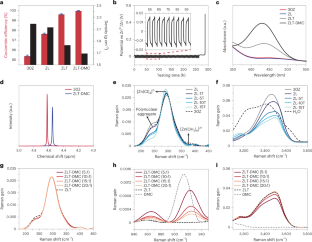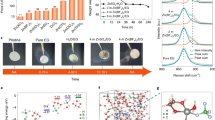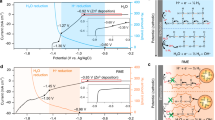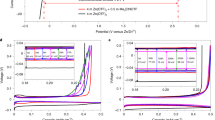Abstract
Rechargeable aqueous zinc batteries are finding their niche in stationary storage applications where safety, cost, scalability and carbon footprint matter most. However, harnessing this reversible two-electron redox chemistry is plagued by major technical issues, notably hydrogen evolution reaction (HER) at the zinc surface, whose impacts are often not revealed under typical measurement conditions. Here we report a concentrated electrolyte design that eliminates this parasitic reaction and enables a Coulombic efficiency (CE) of 99.95% for Zn plating/stripping measured at a low current density of 0.2 mA cm−2. With extra chloride salts and dimethyl carbonate in concentrated ZnCl2 electrolyte, the hybrid electrolyte with a unique chemical environment features low Hammett acidity and facilitates the in situ formation of a dual-layered solid electrolyte interphase, protecting zinc anodes from HER and dendrite growth. Benefiting from the near-unity CE, the pouch cell with a VOPO4·2H2O cathode sustains 500 deep cycles without swelling or leaking and delivers an energy density of 100 Wh kg−1 under practical conditions. Our work represents a critical step forward in accelerating the market adoption of zinc batteries as an energy storage system with higher sustainability.
This is a preview of subscription content, access via your institution
Access options
Access Nature and 54 other Nature Portfolio journals
Get Nature+, our best-value online-access subscription
$29.99 / 30 days
cancel any time
Subscribe to this journal
Receive 12 digital issues and online access to articles
$119.00 per year
only $9.92 per issue
Buy this article
- Purchase on Springer Link
- Instant access to full article PDF
Prices may be subject to local taxes which are calculated during checkout




Similar content being viewed by others
Data availability
The data that support the findings of this study are available in the Article and its Supplementary Information.
References
Bauer, C. et al. Charging sustainable batteries. Nat. Sustain. 5, 176–178 (2022).
Grey, C. & Tarascon, J. Sustainability and in situ monitoring in battery development. Nat. Mater. 16, 45–56 (2017).
Li, C., Jin, S., Archer, L. A. & Nazar, L. F. Toward practical aqueous zinc-ion batteries for electrochemical energy storage. Joule 6, 1727–1742 (2022).
Liu, C., Xie, X., Lu, B., Zhou, J. & Liang, S. Electrolyte strategies toward better zinc-ion batteries. ACS Energy Lett. 6, 1015–1033 (2021).
Song, J., Xu, K., Liu, N., Reed, D. & Li, X. Crossroads in the renaissance of rechargeable aqueous zinc batteries. Mater. Today 45, 191–212 (2021).
Wang, S.-B. et al. Lamella-nanostructured eutectic zinc–aluminum alloys as reversible and dendrite-free anodes for aqueous rechargeable batteries. Nat. Commun. 11, 1634 (2020).
Zheng, J. et al. Reversible epitaxial electrodeposition of metals in battery anodes. Science 366, 645–648 (2019).
Ma, L. et al. Hydrogen-free and dendrite‐free all-solid-state Zn-ion batteries. Adv. Mater. 32, 1908121 (2020).
Zeng, Y. et al. Dendrite-free zinc deposition induced by multifunctional CNT frameworks for stable flexible Zn-ion batteries. Adv. Mater. 31, 1903675 (2019).
Qiu, H. et al. Zinc anode-compatible in-situ solid electrolyte interphase via cation solvation modulation. Nat. Commun. 10, 5374 (2019).
Wang, Z. et al. A metal-organic framework host for highly reversible dendrite-free zinc metal anodes. Joule 3, 1289–1300 (2019).
Wang, F. et al. Highly reversible zinc metal anode for aqueous batteries. Nat. Mater. 17, 543–549 (2018).
Zheng, J. & Archer, L. A. Controlling electrochemical growth of metallic zinc electrodes: toward affordable rechargeable energy storage systems. Sci. Adv. 7, eabe0219 (2021).
Xie, X. et al. Manipulating the ion-transfer kinetics and interface stability for high-performance zinc metal anodes. Energy Environ. Sci. 13, 503–510 (2020).
Suo, L. et al. “Water-in-salt” electrolyte enables high-voltage aqueous lithium-ion chemistries. Science 350, 938–943 (2015).
Zhang, C. et al. The electrolyte comprising more robust water and superhalides transforms Zn-metal anode reversibly and dendrite-free. Carbon Energy 3, 339–348 (2021).
Zhao, J. et al. “Water-in-deep eutectic solvent” electrolytes enable zinc metal anodes for rechargeable aqueous batteries. Nano Energy 57, 625–634 (2019).
Xie, J., Liang, Z. & Lu, Y.-C. Molecular crowding electrolytes for high-voltage aqueous batteries. Nat. Mater. 19, 1006–1011 (2020).
Han, D. et al. A non-flammable hydrous organic electrolyte for sustainable zinc batteries. Nat. Sustain. 5, 205–213 (2022).
Cao, L. et al. Fluorinated interphase enables reversible aqueous zinc battery chemistries. Nat. Nanotechnol. 16, 902–910 (2021).
Yuan, L. et al. Regulation methods for the Zn/electrolyte interphase and the effectiveness evaluation in aqueous Zn-ion batteries. Energy Environ. Sci. 14, 5669–5689 (2021).
Li, C. et al. Highly reversible Zn anode with a practical areal capacity enabled by a sustainable electrolyte and superacid interfacial chemistry. Joule 6, 1103–1120 (2022).
Zhao, Z. et al. Horizontally arranged zinc platelet electrodeposits modulated by fluorinated covalent organic framework film for high-rate and durable aqueous zinc ion batteries. Nat. Commun. 12, 6606 (2021).
Li, D., Cao, L., Deng, T., Liu, S. & Wang, C. Design of a solid electrolyte interphase for aqueous Zn batteries. Angew. Chem. Int. Ed. 60, 13035–13041 (2021).
Cao, L. et al. Solvation structure design for aqueous Zn metal batteries. J. Am. Chem. Soc. 142, 21404–21409 (2020).
Zhang, Q. et al. Designing anion-type water-free Zn2+ solvation structure for robust Zn metal anode. Angew. Chem. Int. Ed. 133, 23545–23552 (2021).
Yang, H. et al. Constructing a super-saturated electrolyte front surface for stable rechargeable aqueous zinc batteries. Angew. Chem. Int. Ed. 59, 9377–9381 (2020).
Sui, Y. & Ji, X. Anticatalytic strategies to suppress water electrolysis in aqueous batteries. Chem. Rev. 121, 6654–6695 (2021).
Pang, Q. et al. Fast-charging aluminium–chalcogen batteries resistant to dendritic shorting. Nature 608, 704–711 (2022).
Ma, L. et al. Realizing high zinc reversibility in rechargeable batteries. Nat. Energy 5, 743–749 (2020).
Adams, B. D., Zheng, J., Ren, X., Xu, W. & Zhang, J. G. Accurate determination of coulombic efficiency for lithium metal anodes and lithium metal batteries. Adv. Energy Mater. 8, 1702097 (2018).
Ma, L. et al. Critical factors dictating reversibility of the zinc metal anode. Energy Environ. Mater. 3, 516–521 (2020).
Hao, J. et al. Boosting zinc electrode reversibility in aqueous electrolytes by using low‐cost antisolvents. Angew. Chem. Int. Ed. 60, 7366–7375 (2021).
Duffy, J. & Ingram, M. Acidic nature of metal aquo complexes: proton-transfer equilibriums in concentrated aqueous media. Inorg. Chem. 17, 2798–2802 (1978).
Sun, Q. Local statistical interpretation for water structure. Chem. Phys. Lett. 568, 90–94 (2013).
Choe, C., Lademann, J. & Darvin, M. E. Depth profiles of hydrogen bound water molecule types and their relation to lipid and protein interaction in the human stratum corneum in vivo. Analyst 141, 6329–6337 (2016).
Hwang, H. et al. Hydration breaking and chemical ordering in a levitated NaCl solution droplet beyond the metastable zone width limit: evidence for the early stage of two-step nucleation. Chem. Sci. 12, 179–187 (2021).
Wang, F. et al. Hybrid aqueous/non-aqueous electrolyte for safe and high-energy Li-ion batteries. Joule 2, 927–937 (2018).
Yang, C. et al. Aqueous Li-ion battery enabled by halogen conversion–intercalation chemistry in graphite. Nature 569, 245–250 (2019).
Sun, W. et al. A rechargeable zinc-air battery based on zinc peroxide chemistry. Science 371, 46–51 (2021).
Peled, E. The electrochemical behavior of alkali and alkaline earth metals in nonaqueous battery systems—the solid electrolyte interphase model. J. Electrochem. Soc. 126, 2047 (1979).
Peled, E. & Menkin, S. SEI: past, present and future. J. Electrochem. Soc. 164, A1703 (2017).
Cao, L. et al. Highly reversible aqueous zinc batteries enabled by Zincophilic–Zincophobic interfacial layers and interrupted hydrogen‐bond electrolytes. Angew. Chem. Int. Ed. 60, 18845–18851 (2021).
Yuan, Y. et al. Understanding intercalation chemistry for sustainable aqueous zinc–manganese dioxide batteries. Nat. Sustain. 5, 890–898 (2022).
Zhang, Q. et al. Modulating electrolyte structure for ultralow temperature aqueous zinc batteries. Nat. Commun. 11, 4463 (2020).
Ge, J., Fan, L., Rao, A. M., Zhou, J. & Lu, B. Surface-substituted Prussian blue analogue cathode for sustainable potassium-ion batteries. Nat. Sustain. 5, 225–234 (2022).
Wang, F. et al. How water accelerates bivalent ion diffusion at the electrolyte/electrode interface. Angew. Chem. Int. Ed. 57, 11978–11981 (2018).
Chiu, N. et al. Designing dual-functional metal–organic frameworks for photocatalysis. Chem. Mater. 34, 8798–8807 (2022).
Zhu, L., Liu, W. & Fang, C. A versatile femtosecond stimulated Raman spectroscopy setup with tunable pulses in the visible to near infrared. Appl. Phys. Lett. 105, 041106 (2014).
Tang, L. et al. Excited state structural evolution of a GFP single-site mutant tracked by tunable femtosecond-stimulated Raman spectroscopy. Molecules 23, 2226 (2018).
Acknowledgements
H.J. acknowledges the financial support from NSF SBIR-2012221. X.J., C.F., and P.A.G. thank the financial support from US NSF Award CBET-2038381 (X.J., C.F.) and CBET-2038366 (P.A.G.). J.L. acknowledges support as part of the Hydrogen in Energy and Information Sciences, an Energy Frontier Research Center funded by US DOE Award DE-SC0023450. This work made use of instruments in the Electron Microscopy Service and Nuclear Magnetic Resonance Facility (Oregon State University). X.J. thanks Dr. Peter Eschbach, Stephen Huhn, and Dr. Patrick Reardon for their instrument assistance.
Author information
Authors and Affiliations
Contributions
X.J. conceived the concept for the research. H.J. designed the experiments and analysed data with assistance from S.K.S., G.L., D.H. and J.J.H. GS-FSRS measurements were performed by L.T. under the guidance of C.F. P.A.G. supervised the AIMD simulation that Y.F. carried out. J.L. supervised the in situ optical microscopies that S.W. performed. D.H. and N.-C.C. performed the ultraviolet–visible spectroscopy and gas chromatography tests under the supervision of K.C.S. A.M.S. collected the nuclear magnetic resonance data, and W.F.S. conducted the X-ray photoelectron spectroscopy measurements. X.J., C.F., P.A.G., J.L. and D.W. supervised the project. All authors contributed to interpreting the results, discussed the data and reviewed the final draft.
Corresponding authors
Ethics declarations
Competing interests
X.J. and H.J. are inventors on US patent application no. 17/867,672 filed by GROTTHUSS INC. regarding the formula of the electrolytes described in this Article. The other authors declare no competing interests.
Peer review
Peer review information
Nature Sustainability thanks Longsheng Cao and the other, anonymous, reviewer(s) for their contribution to the peer review of this work.
Additional information
Publisher’s note Springer Nature remains neutral with regard to jurisdictional claims in published maps and institutional affiliations.
Supplementary information
Supplementary Information
Supplementary figs. 1–30, tables 1–4 and discussion.
In situ optical microscopy video of ZMA plating in ZLT-DMC.
In situ optical microscopy video of ZMA plating in 30Z-DMC.
In situ optical microscopy video of ZMA plating in ZLT.
In situ optical microscopy video of ZMA plating in ZL.
In situ optical microscopy video of ZMA plating in 30Z.
Rights and permissions
Springer Nature or its licensor (e.g. a society or other partner) holds exclusive rights to this article under a publishing agreement with the author(s) or other rightsholder(s); author self-archiving of the accepted manuscript version of this article is solely governed by the terms of such publishing agreement and applicable law.
About this article
Cite this article
Jiang, H., Tang, L., Fu, Y. et al. Chloride electrolyte enabled practical zinc metal battery with a near-unity Coulombic efficiency. Nat Sustain 6, 806–815 (2023). https://doi.org/10.1038/s41893-023-01092-x
Received:
Accepted:
Published:
Issue Date:
DOI: https://doi.org/10.1038/s41893-023-01092-x
This article is cited by
-
Safe electrolyte for long-cycling alkali-ion batteries
Nature Sustainability (2024)
-
Best practices for zinc metal batteries
Nature Sustainability (2024)
-
A weakly solvating electrolyte towards practical rechargeable aqueous zinc-ion batteries
Nature Communications (2024)
-
Polyzwitterionic cross-linked double network hydrogel electrolyte enabling high-stable Zn anode
Nano Research (2024)
-
Ultrathin Zincophilic Interphase Regulated Electric Double Layer Enabling Highly Stable Aqueous Zinc-Ion Batteries
Nano-Micro Letters (2024)



